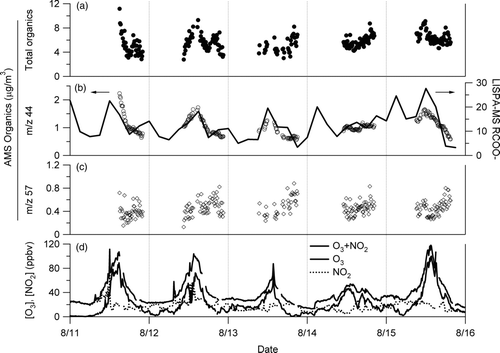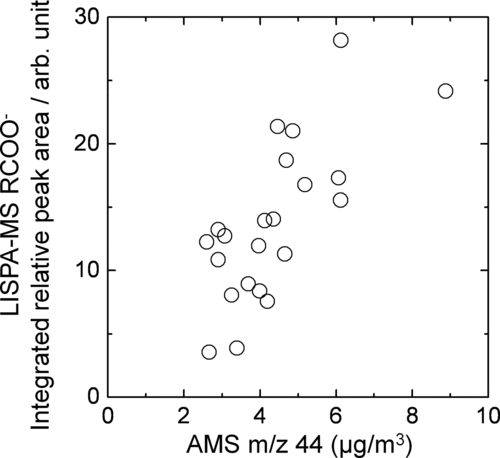Figures & data
FIG. 1 Temporal variation in (a) weight-based fraction of non-refractory components in aerosol particles and (b) mass concentration summed over organic aerosol (green), nitrate (blue), sulfate (red), ammonium (orange), and chloride (pink), as observed by AMS. AMS measurements were conducted mostly in daytime. Temporal variation in the three-hour integrated relative peak areas of (c) m/z 97 (HSO– 4) and (d) m/z 18 (NH+ 4), as measured by LISPA-MS. For discussion purposes, the observation period was divided into two periods named Period I (14:40, 11 August to 12:00, 13 August) and Period II (10:50, 14 August to 20:30, 15 August) as indicated (see the text). The numbers of particles counted both in positive and negative ion measurement modes are plotted for each three-hour bin in panel (e).
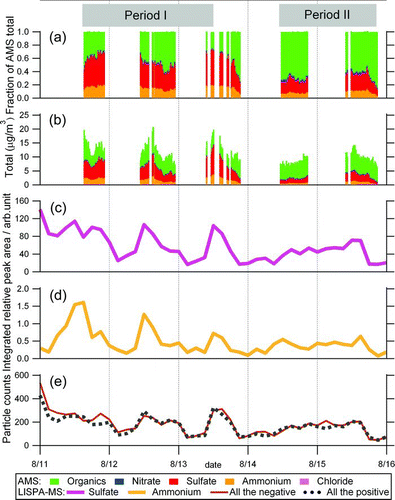
FIG. 2 Typical negative- and positive-ion mass spectra of individual particles observed by LISPA-MS, with assignments of the corresponding ions: (a) sulfate (m/z 97) and nitrate (m/z 46 and 62), (b) ammonium (m/z 18) and C+, Na+, K+, V+, and Fe+, and (c) organics as well as sulfate and nitrate.
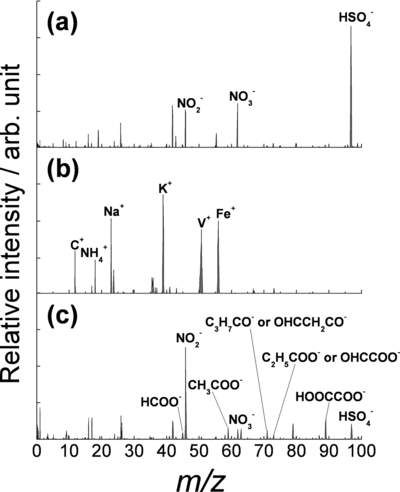
FIG. 3 Correlation plots for LISPA-MS relative peak area and AMS mass loading: (a) sulfate and (b) ammonium. Note that LISPA-MS peak areas were integrated over each 3-h bin, whereas AMS mass concentrations (originally logged as 10-min interval data) were averaged over each three-hour bin for comparison.
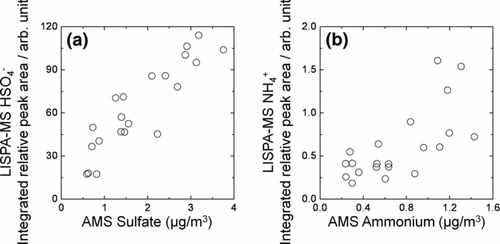
FIG. 4 Correlation plots for the mass concentrations observed by AMS and the potential ozone of [O3] + [NO2]: (a) Nitrate versus organics, (b) nitrate versus m/z 44, (c) nitrate versus m/z 57, (d) potential ozone versus organics, (e) potential ozone versus m/z 44, and (f) the potential ozone versus m/z 57. Those plots include all data over Periods I and II.
![FIG. 4 Correlation plots for the mass concentrations observed by AMS and the potential ozone of [O3] + [NO2]: (a) Nitrate versus organics, (b) nitrate versus m/z 44, (c) nitrate versus m/z 57, (d) potential ozone versus organics, (e) potential ozone versus m/z 44, and (f) the potential ozone versus m/z 57. Those plots include all data over Periods I and II.](/cms/asset/8d526443-a733-456c-a2cb-76c1cfdecb51/uast_a_533720_o_f0004g.gif)
TABLE 1 Mass peaks (m/z) explored as candidate markers of organics in negative-ion mass spectra measured by LISPA-MS and their possible assignment of corresponding ions
FIG. 5 Temporal variations in total organics, m/z 44, and m/z 57, as measured by AMS (10-min interval), and the three-hour integrated signals of RCOO–, as measured by LISPA-MS, along with gaseous O3 and NO2 concentrations. The definition of LISPA-MS RCOO– is described in the text. Measurements of gas-phase ozone (Thermo Electron, 49C) and NO x (Ecophysics, CLD88yp) were performed at the same sampling site.
